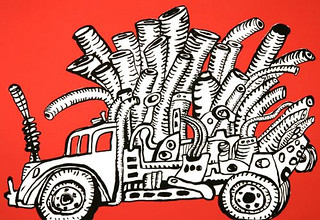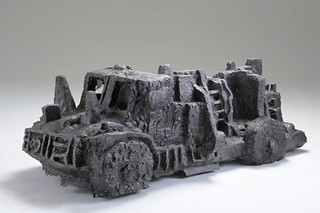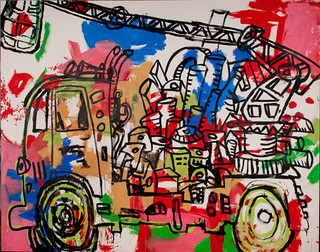Workhorse that delivered American Dream featured in art museum exhibition
Article body
Chicago-based artist John Himmelfarb's exhibition, "TRUCKS," will be on view at Auburn University's Jule Collins Smith Museum of Fine Art from Saturday, Jan. 24, through Sunday, May 10. The survey of work, more than a decade in the making, showcases the iconic image of trucks as represented in painting, drawing, sculpture and printmaking.
Whether you are brand loyal to Ford or Chevrolet, there's an association that's uniquely American about the truck. Covered in mud or meticulously detailed, the vehicle is a symbol of pride for some drivers. Workers haul their tools and materials for a tough job. Travelers use them to shuttle from point A to point B.
That personal connection for the viewer and the transportation of ideas is what Himmelfarb considers in his exhibition. His artwork is found in the permanent collections of the High Museum of Art in Atlanta, the Museum of Modern Art in New York City, the Smithsonian Museum of American Art in Washington, D.C., and Auburn's Jule Collins Smith Museum of Fine Art.
Included in the installation at Auburn is "Penelope Awaiting Her Chamberlain," an outdoor sculpture made from a 1946 Chevrolet farm truck and piled high with found objects, like rusty barrels and canisters. Himmelfarb often drives this most recent work to different exhibition venues, in some nerve-wracking conditions, creating road trip stories wherever he goes.
"The first time I drove Penelope at any distance was about 35 miles on rural roads, up big hills. I've driven through snow and ice to deliver the sculpture," said Himmelfarb.
"Truck drivers would come over to see what I was hauling pretty much everywhere I went. It generated a lot of conversation. People would stop and say 'my grandfather had a truck like this one.' People loved to have their pictures taken with it and would bring their kids," he said.
"Penelope" is named as a nod to Penelope of Greek mythology – remembered for her faithfulness as a wife awaiting the return of her warrior husband – and to the late John Chamberlain, a famed sculptor who often used old automobiles and parts as a medium.
Himmelfarb said he enjoyed talking to people about his artwork. Visitors will have that opportunity when the artist works on an unfinished, 35-foot-long painting on display in the museum's Bill L. Harbert Gallery during an artist-in-residency program Saturday, Jan. 24, through Friday, Jan. 30.
"I thought I was done with the painting at the time, but then the more I looked at it, I thought I hadn't really finished it," he said. "I don't exactly know where it's going to go. In general, I don't usually plan out my work too much. The main challenge is just to get it up on the wall and get my studio set up in the museum so I can work comfortably."
Himmelfarb said there's an excitement factor involved when working in public, along with a chance to engage with people. "You know you can always go in the studio, record something, and then delete the mistakes, but when you perform live on stage you want it to be as right as possible," he said.
"I think I make artwork in the first place in order to share my enthusiasm with other people. Getting them interested in it by letting them see it developing is a way of facilitating their understanding and enjoyment of it, which is what I'm hoping to achieve in the first place."
Other programs associated with "TRUCKS" include the Thursday series "FILM@JCSM: American Transport," where interdisciplinary scholars from Auburn and other institutions moderate a post-film discussion; "A Little Art Talks" on Wednesdays at noon, featuring conversations with Auburn students about works on display; and a K-12 Art Club called "Keep on Truckin," for younger students to explore Himmelfarb's artwork and hands-on activities. The programs are free and open to the public. Museum admission is free courtesy of JCSM Business Partners. For more information, visit www.jcsm.auburn.edu or call (334) 844-1484.
Related Media
Related Links
Media interested in this story can contact Communications Director Preston Sparks at (334) 844-9999 or preston.sparks@auburn.edu.
Auburn University is a nationally ranked land grant institution recognized for its commitment to world-class scholarship, interdisciplinary research with an elite, top-tier Carnegie R1 classification, life-changing outreach with Carnegie’s Community Engagement designation and an undergraduate education experience second to none. Auburn is home to more than 30,000 students, and its faculty and research partners collaborate to develop and deliver meaningful scholarship, science and technology-based advancements that meet pressing regional, national and global needs. Auburn’s commitment to active student engagement, professional success and public/private partnership drives a growing reputation for outreach and extension that delivers broad economic, health and societal impact.








